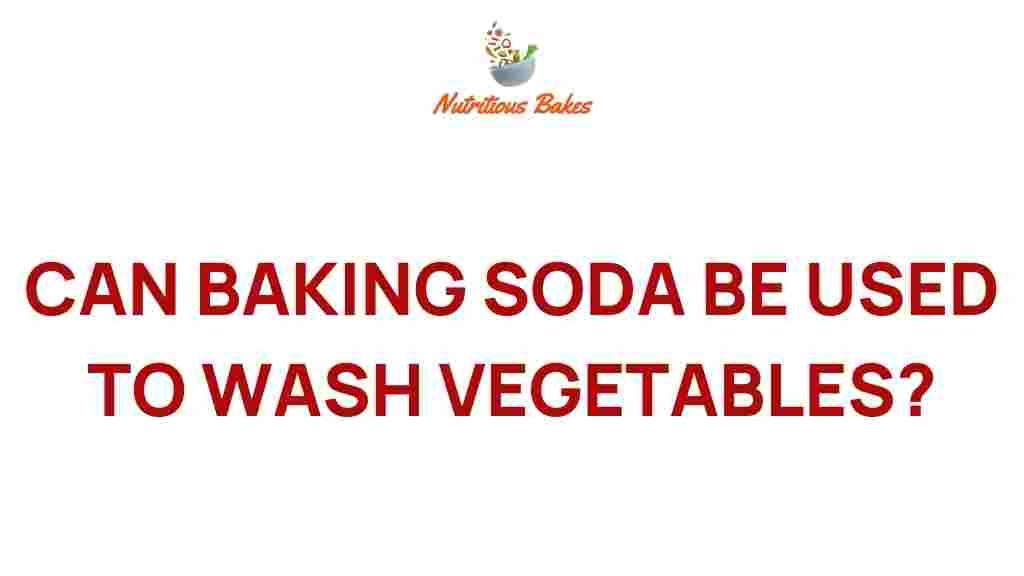Unveiling the Truth: Can Baking Soda Really Clean Your Vegetables?
In our quest for health and food safety, the question of how to effectively clean our vegetables often arises. Many home cooks and health enthusiasts have turned to baking soda as a natural cleaning agent. This article explores the effectiveness of baking soda in vegetable cleaning, its benefits, and how to properly use it to ensure that your organic produce is safe for consumption. We’ll also provide some kitchen tips and culinary hacks that can enhance your cooking experience.
The Benefits of Cleaning Your Vegetables
Before diving into the specifics of using baking soda for vegetable cleaning, it’s important to understand why cleaning your produce is essential:
- Food Safety: Washing vegetables removes dirt, pesticides, and harmful bacteria that can lead to foodborne illnesses.
- Improved Taste: Clean vegetables taste better and contribute to a more enjoyable culinary experience.
- Longer Shelf Life: Properly cleaned and dried vegetables tend to last longer when stored.
Why Choose Baking Soda for Vegetable Cleaning?
Baking soda, or sodium bicarbonate, stands out as a popular choice for cleaning produce due to several reasons:
- Natural and Non-Toxic: Unlike many commercial cleaning agents, baking soda is safe for food and does not leave harmful residues.
- Effective Against Pesticides: Studies have shown that baking soda can help remove pesticide residues from the surface of fruits and vegetables.
- Affordable and Accessible: Baking soda is a common household item that is easy to find and inexpensive.
How to Clean Vegetables with Baking Soda
Now that we understand the benefits, let’s explore a step-by-step process for cleaning your vegetables using baking soda:
Step 1: Gather Your Supplies
To clean your vegetables effectively, you will need:
- Baking Soda: 1-2 tablespoons
- Water: About 1-2 cups
- A Bowl or Basin: For soaking
- Vegetables: Any type you wish to clean (e.g., lettuce, carrots, tomatoes)
- Brush (optional): For scrubbing hard-skinned vegetables
Step 2: Prepare the Cleaning Solution
In a bowl or basin, mix 1-2 tablespoons of baking soda with 1-2 cups of water. Stir the mixture until the baking soda is fully dissolved. This solution acts as a gentle abrasive that can lift dirt and residues from your produce.
Step 3: Soak the Vegetables
Place your vegetables in the baking soda solution, ensuring they are fully submerged. Let them soak for about 5-10 minutes. This soaking time allows the baking soda to penetrate and break down any contaminants on the surface.
Step 4: Scrub and Rinse
For hard-skinned vegetables like potatoes or carrots, use a vegetable brush to scrub the surface gently. After scrubbing, rinse the vegetables thoroughly under cold running water to remove any remaining baking soda and dirt.
Step 5: Dry and Store
After rinsing, pat the vegetables dry with a clean kitchen towel or let them air dry. Proper drying prevents moisture buildup, which can lead to spoilage.
Troubleshooting Tips for Using Baking Soda
While cleaning vegetables with baking soda is generally effective, you may encounter some issues. Here are some troubleshooting tips:
Vegetables Still Look Dirty
If your vegetables still appear dirty after cleaning, consider:
- Allowing them to soak for a longer period.
- Using a brush to scrub them more thoroughly.
- Increasing the concentration of baking soda in your solution.
Unpleasant Taste or Residue
If you notice an unpleasant taste or residue after cleaning, ensure you rinse the vegetables thoroughly. It’s crucial to remove all traces of baking soda to avoid any lingering flavors.
Not Removing Pesticides
While baking soda is effective for many pesticides, some may require more specific cleaning methods. For heavily contaminated produce, consider:
- Using a commercial produce wash.
- Peeling the skin of fruits and vegetables.
- Choosing organic produce when possible to minimize pesticide exposure.
Additional Kitchen Tips and Culinary Hacks
In addition to using baking soda for vegetable cleaning, here are some kitchen tips and culinary hacks to enhance your cooking and food safety:
- Use Vinegar: Combine vinegar with baking soda for an extra cleaning boost, especially for leafy greens.
- Check for Freshness: Always inspect your produce for signs of spoilage before cleaning and cooking.
- Store Properly: Keep cleaned vegetables in airtight containers in the refrigerator to maintain freshness.
- Incorporate Variety: Include a range of vegetables in your diet to maximize health benefits.
- Cook Thoroughly: Ensure that all vegetables are cooked to safe temperatures to eliminate any remaining bacteria.
Resources for Further Reading
For more information on food safety and cleaning agents, check out this informative article that delves deeper into the subject.
Conclusion
In conclusion, baking soda is an effective and safe method for cleaning your vegetables, enhancing food safety without introducing harmful chemicals. By following the step-by-step guide outlined above, you can ensure that your organic produce is clean and ready for consumption. Remember to combine this method with other kitchen tips and culinary hacks to maximize the health benefits of your meals. So next time you’re in the kitchen, grab that box of baking soda and start cleaning your vegetables with confidence!
For more culinary tips and health information, consider following our blog for the latest updates and hacks!
This article is in the category Tips and created by NutritiousBakes Team
